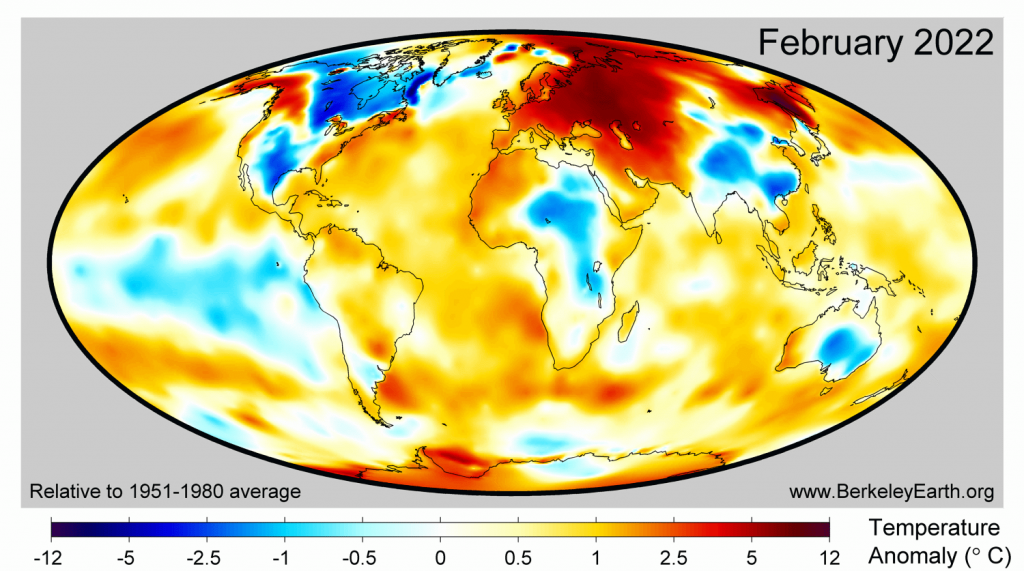The following is a summary of global temperature conditions in Berkeley Earth’s analysis of February 2022.
- February 2022 was the 8th warmest February since records began in 1850.
- Warm conditions occurred over parts of Europe, the Middle East, and parts of Asia.
- Unusually cool conditions were present in parts of North America and the equatorial Pacific.
- La Niña conditions are present and are likely to keep 2022 cooler than recent record years.
- 2022 is nearly certain to be one of the top ten warmest years, but unlikely to be a new warmest year (only a ~6% chance of a new record).
Global Summary
Globally, February 2022 has been the eighth warmest February since records began in 1850. This February is notably cooler than Februarys in 2016 and 2020, though it is warmer than in February 2021. Other recent years were similar, including 2018, 2015, 2010, and 1998. Both 2021 and 2022 began with La Niña conditions, which tend to slightly reduce global average temperatures.

The global mean temperature in February 2022 was 0.87 ± 0.04 °C (1.57 ± 0.07 °F) above the 1951 to 1980 average.
This is equivalent to being 1.20 ± 0.06 °C (2.16 ± 0.11 °F) above the 1850 to 1900 average, which is frequently used as a benchmark for the preindustrial period.
The global mean temperature anomaly in February 2022 was similar to that for January 2022, and several other recent months. Temperatures in February were somewhat below the long-term trend line but consistent with natural variability, and in particular, with the effect of the ongoing La Niña conditions.

Spatial Variation
February 2022 continues the ongoing pattern of wide-spread warmth, though with some notable exceptions. Particularly warm conditions were present in Europe and most of the Middle East and Asia. Record setting warmth was present in the Pacific Ocean and portions of the Southern Atlantic. Particularly cool conditions were present in parts of North America, Southeast Asia, as well as the Eastern equatorial Pacific Ocean.
The warmth across Asia is particularly prominent on our maps. However, due to its geography, Asia often experiences larger weather variations in winter than most other regions. Despite having some of the largest temperature anomalies on the present map, most of Asia did not experience record warmth in February, and the average across Asia was only the 7rd warmest for February.
We estimate that 1.2% of the Earth’s surface experienced their locally warmest February average, and 69% of the Earth’s surface was significantly warm when compared to their local average during the period 1951 to 1980. In addition, 0.01% on Earth’s surface had their locally coldest February.
The cool area in the Eastern Pacific, is consistent with the ongoing La Niña conditions.


Over land regions, 2022 was the 13th warmest February, coming in as 1.15 ± 0.07 °C (2.06 ± 0.12 °F) above the 1951 to 1980 average.
February 2022 was the 5th warmest February in the oceans, recorded as 0.61 ± 0.04 °C (1.09 ± 0.07 °F) above the 1951 to 1980 average.


Northern Winter 2021/2022
The Northern Hemisphere Winter (December 2021-February 2022) was the 6th warmest on record, with an average temperature of 0.89 ± 0.04 °C (1.60 ± 0.08 °F) above the 1951 to 1980 average. This period was slightly warmer than last year but cooler than several previous years. This moderate cooling compared to recent years is likely due to the ongoing La Niña which was prominent in the Pacific Ocean,


La Niña
February 2022 showed moderate La Niña conditions in the Pacific Ocean. The La Niña phenomenon, associated with relatively cool water in the Eastern equatorial Pacific, is a form of seasonal weather variability that is generally associated with cooler global average temperatures. The current La Niña event is expected to continue for at least a few more months. The CPC/IRI analysis suggests that neutral conditions may return this summer though with a high degree of uncertainty regarding timing and future conditions.

Rest of 2022
The ongoing La Niña event makes it likely that 2022 will be cooler than recent record warm years; however, 2022 is nearly certain to remain within the top ten warmest years overall. If La Niña dissipates, the annual average might be expected to warm some during the latter half of 2022 compared to the first half of the year, but the full year is unlikely to challenge the previous record warm years.
The statistical approach that we use, looking at conditions in January and prior months, believes that 2022 is most likely to be the 4th or 5th warmest year in the instrumental record, with about a 60% chance of one of these outcomes. There is a small chance (6%) that the remainder of 2022 warms enough to be a record warm year. It is very unlikely that 2022 will be any cooler than the 8th warmest, which means that this year is very likely to still surpass all years prior to 2015.

Likelihood of final 2022 ranking:
- 1st place (6 %)
- Top 3 overall (13 %)
- 4th place (33 %)
- 5th place (27 %)
- 6th, 7th, or 8th place (26 %)
- Top 8 overall (99 %)


